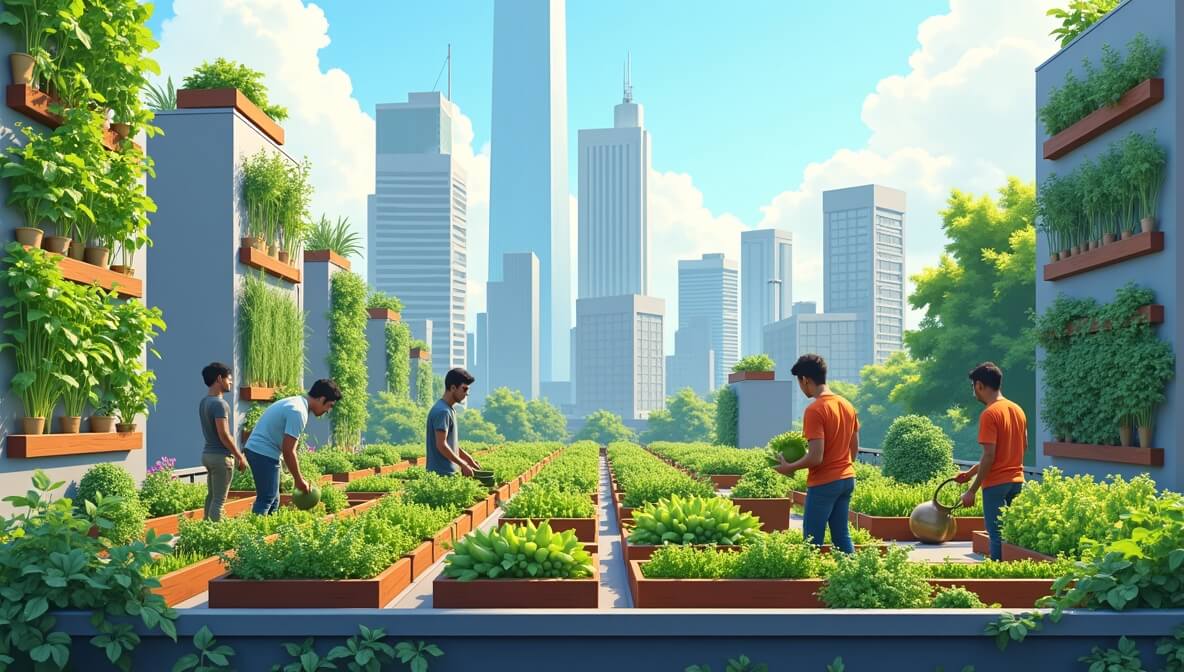September 05, 2025

As urban populations surge, so do the challenges of feeding them sustainably. Urban farming—the practice of cultivating, processing, and distributing food in and around cities—offers a powerful, multi-dimensional solution to hunger, poverty, and environmental degradation.
From rooftop greenhouses to community gardens, urban agriculture is not just about growing food—it’s about building resilient communities, empowering individuals, and reimagining how cities can nourish both people and the planet.
As of today, over half the world’s population lives in urban areas, and the number is expected to reach nearly 70% by 2050 (FAO). Urbanization presents immense pressure on food systems, especially for those already living in poverty.
Urban farming addresses these interrelated problems by providing localized food production, increasing access to healthy food, and creating jobs in the process.
Urban farming takes many forms depending on space availability, technology, and community goals. Here are several proven models:
Rooftops are often underutilized spaces in dense cities. Rooftop farms like Brooklyn Grange (NYC) and Lufa Farms (Montreal) demonstrate how food production can coexist with urban infrastructure, producing thousands of pounds of produce annually while reducing building energy use.
Benefits:
Community gardens are collaborative spaces where residents grow fruits, vegetables, and herbs. These spaces are often built on vacant lots or unused land and are maintained by neighborhood volunteers.
Benefits:
Many cities, such as Detroit, Los Angeles, and Nairobi, have implemented city-wide community gardening networks to revitalize neighborhoods.
In locations where space is extremely limited, soil-free systems like hydroponics and aquaponics offer a solution. These technologies grow crops using nutrient-rich water and stacked structures, often indoors.
Benefits:
These systems are being used in schools, shipping containers, basements, and even subway stations in cities like Tokyo, London, and Singapore.
Urban farms linked with schools and nonprofits educate youth about nutrition, science, environmental stewardship, and job readiness. These “learning gardens” can be integrated into school curriculums and after-school programs.
Examples include:
Urban agriculture can be a powerful tool to promote equity and self-determination, particularly in communities historically impacted by systemic racism, underinvestment, and food apartheid.
Programs like Soul Fire Farm (NY) and Plant It Forward (TX) actively work with Black, Indigenous, and refugee communities to reclaim their connection to land and food sovereignty.
Additionally, urban farming supports broader social goals including:
Urban farming is also a climate-smart strategy for sustainable development. By localizing food production, cities can shrink their ecological footprint and build climate resilience.
Many urban farms also incorporate rainwater harvesting, solar power, compost toilets, and permaculture techniques to further minimize their environmental impact.
You don’t need to be a farmer to contribute. Here are ways to get involved:
Detroit has become a model for urban farming after decades of economic decline left thousands of vacant lots. Residents, churches, and community organizations have turned this land into over 1,500 urban gardens and farms.
Groups like Keep Growing Detroit and The Greening of Detroit have helped reclaim the city’s land for food, education, and community wellness—demonstrating how urban farming can drive revitalization, not just survival.
In a time of rapid urbanization, climate change, and growing inequality, urban farming represents a hopeful intersection of food justice, environmental sustainability, and community empowerment.
By growing food where people live—and giving them control over how it’s grown—urban agriculture nourishes not just bodies, but cities themselves.
Whether on a balcony, a school roof, or a reclaimed city lot, every square foot of urban soil holds the potential for transformation.
Stay up to date with the latest tips, expert insights, product reviews, and step-by-step guides to help you grow, create, and succeed—no matter your industry or passion.